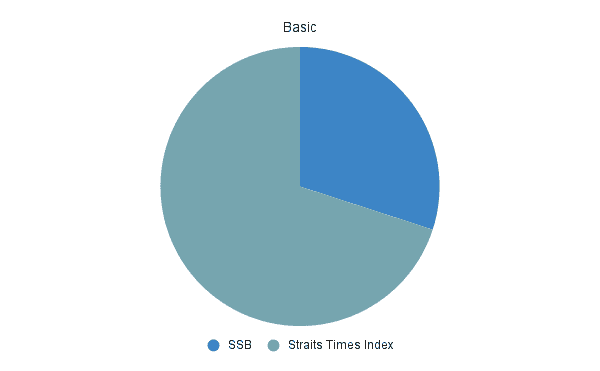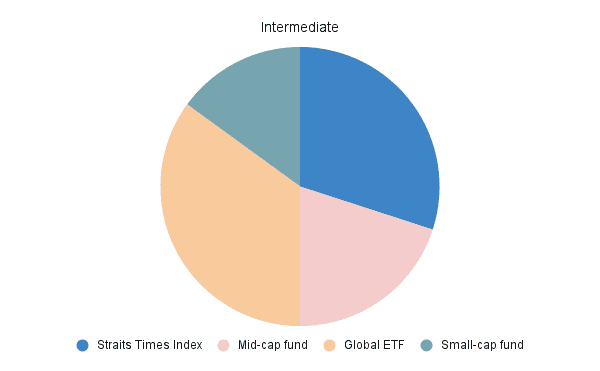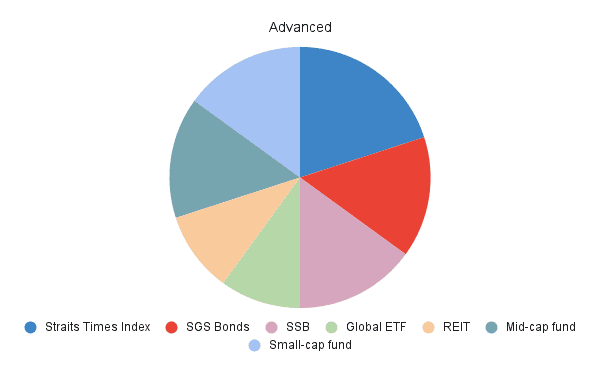How does Investment Diversification Work? (And Its Benefits)
Updated: 11 Apr 2025
Diversification entails spreading assets across different industries, sectors, or classes to reduce risk. Learn how understanding and implementing effective diversification is key to safeguarding your investment.
Written bySingSaver Team
Team
The information on this page is for educational and informational purposes only and should not be considered financial or investment advice. While we review and compare financial products to help you find the best options, we do not provide personalised recommendations or investment advisory services. Always do your own research or consult a licensed financial professional before making any financial decisions.
Diversification is an investment strategy that aims to reduce risk by spreading investments across various asset classes and markets, rather than just concentrating on one asset. It's a key component of asset allocation, which dictates how your portfolio is distributed among different investment types.
This is especially relevant for Singaporean investors who often navigate a complex investment landscape rich with CPF funds, REIT-heavy portfolios, and regional market exposures.
What is the definition of diversification?
Essentially, diversification enables risk management by blending dissimilar assets, like stocks and bonds, to prevent overexposure to any single asset class or market sector. This approach to asset allocation helps manage the inherent volatility of financial markets, protecting your overall portfolio from the ups and downs of the market, and from other influencing forces such as global developments and geopolitics.
» MORE: Learn how robo-advisors can help with diversifying your portfolio
Want to start investing but not sure where to start?
We’ve done the legwork so you don’t need to! Learn how to open a CDP account and start your investing journey.
Example case studies of diversification in action
Consider two scenarios:
Scenario 1: An investor puts all their funds into Singapore REITs. If the local real estate market declines, their entire portfolio suffers as their capital is all tied up in just one asset class.
Scenario 2: An investor builds a diversified portfolio with Singapore stocks, global ETFs, bonds, or even tech stocks. If one sector or asset class underperforms, others can compensate. Having different geographies in your portfolio also hedges against geopolitical circumstances that could severely impact assets in one region of the world, but not others.
By not putting all your eggs in one basket, you aim to protect your overall investment from the potentially devastating impact of a single investment failing.
Benefits of diversification on your portfolio
Generally speaking, spreading investments through diversification minimises the impact of any single loss. If one investment performs poorly, others can help offset those losses, reducing the overall impact on your portfolio.
A well-diversified portfolio is also better equipped to weather market fluctuations, supporting sustained growth and reduced volatility. This allows you to participate in market upswings while limiting the downside during downturns, contributing to long-term financial goals. Instead of experiencing dramatic swings in value, your portfolio is also likely to exhibit more moderate and consistent growth over time.
For Singaporeans, diversification is crucial when investing in CPF funds, REITs, and SGX-listed equities in particular. It provides a buffer against local and global economic uncertainties, ensuring a more resilient investment strategy.
Diversification by asset class
Key asset classes to have in your diversified portfolio include:
-
Stocks (or equities): Offer growth potential but are volatile. In Singapore, this could include stocks listed on the SGX, such as those in the Straits Times Index (STI).
-
Bonds (or fixed income): Provide income and stability. Examples in Singapore include Singapore Government Securities (SGS) Bonds and corporate bonds issued by local companies.
-
Real estate: Can offer consistent cash flow. In Singapore, this can be accessed through REITs listed on the SGX, which allow investors to gain exposure to the local real estate market.
-
ETFs: Diversified baskets of securities. ETFs can provide exposure to various markets and sectors, including those outside of Singapore. Examples include ETFs tracking the STI, S&P 500, or regional indices.
-
Commodities: Can act as a hedge against inflation. Investors can gain exposure to commodities like gold or oil through ETFs or other investment vehicles.
Mixing these assets ensures portfolio resilience by creating a balance between growth potential and stability.
» MORE: Just starting your investment journey? Learn the best investment and asset allocation strategies by age
Diversification within assets
There are several ways to diversify your portfolio within the same asset type. Here are some considerations to keep in mind when building diversified investments:
Diversification within stocks
Diversifying by industry or sector
Different businesses, industries, and sectors are affected differently by economic cycles.
Demand for consumer discretionary goods like clothing, electronics, or even banking, for example, tends to rise and fall in tandem with the economy. So your assets in luxury goods, REIT, or vehicles might take a hit when the economy is poorer.
Whereas consumer staples like groceries, utilities, and healthcare have a consistent demand regardless of the state of the economy. Even if grocery prices go up, people will still need to eat, after all.
To diversify by industry or sector, avoid over-concentration in Singapore's dominant banking and REIT sectors. Explore sectors like technology (e.g., tech manufacturing), healthcare (e.g. medical device companies), manufacturing, or consumer staples instead, especially companies that export their products globally (leaving them less vulnerable to regional geopolitical factors).
Diversifying by asset size or market capitalisation
Balance small-cap, mid-cap, and large-cap stocks. In layman terms, this just refers to how big or small a company is. Large-cap companies are generally more stable and resilient against economic downturns, while small-cap companies may offer higher growth potential.
You can find companies of varying sizes listed on the SGX. Local large-cap stocks tend to be household names like DBS or Sheng Siong, while local mid- and small-cap stocks tend to be SMEs like 50X Mary Chia (Beauty & Aesthetics Centres) or SEJ Noontalk Media (Artiste Management & Media Agency).
Diversifying by asset style (growth vs. value)
Growth stocks, such as those in the tech sector, tend to have higher growth potential but may be more volatile. Value stocks, such as blue-chip stocks, tend to be more stable and may offer regular dividends.
A diversified portfolio should have a balance of both growth and value stocks to smooth portfolio returns.
» MORE: How to buy stocks and shares in Singapore
Diversification within bonds
Diversifying by credit quality
Not all bonds are created equal. They have different levels of reliability, typically corresponding to the issuer's creditworthiness and predicted level of return. Singapore Government Securities (SGS) Bonds are considered very safe, for instance, as they are backed by the Singapore government, while corporate bonds offer varying levels of risk and return.
It’s recommended to mix high-quality government bonds with corporate bonds.
Diversifying by maturity
Short-term bonds are less sensitive to interest rate changes, while long-term bonds offer higher yields but are more susceptible to interest rate risk. It’s recommended to balance short-term and long-term bonds in order to optimise your yield over time.
Diversifying by type of issuer
Singapore Savings Bonds (SSBs), SGS Bonds, and corporate bonds are just some of the different types of bonds from different issuers in Singapore. While SSBs and SGS bonds are both backed by the government, they have different maturities and interest rates that make them better suited for different investors.
» Learn more: Complete guide to Singapore Savings Bond (SSB)
Diversification within stocks and bonds
Diversifying by geography
Diversifying beyond Singapore allows you to tap into different economic growth cycles and reduce your reliance on the local economy. If possible, invest in US, China, ASEAN, and global markets to spread your risk out even further
Diversifying by active vs. passive investing
Active fund management involves professional fund managers who select investments or suggest suitable mutual funds that align to your investing goals, while passive investing through exchange traded funds (ETFs) or index funds tracks a specific market index.
Robo-advisors like Syfe, StashAway, and Endowus can also offer automated and diversified investment portfolios, typically through a passive investment strategy.
Diversification beyond asset class
To further enhance diversification and potentially improve risk-adjusted returns, you can consider alternative investments as well. However, these have varying rates of return so always do your due diligence and research before investing.
Gold and cryptocurrencies can serve as a hedge against inflation and market volatility. Gold is a traditional safe-haven asset, while cryptocurrencies offer potential for high returns but are highly volatile.
Private equity offers potential for high returns but is less liquid and carries higher risk. This involves investing in privately held companies, which can offer significant growth potential but requires a long-term investment horizon.
Insurance-Linked Investment Plans (ILPs) combine insurance protection with investment components. These plans offer a way to diversify your portfolio while also providing insurance coverage, although rates of return are typically less compared to playing the stock market.
If you’re looking into real estate, REITs provide access to the real estate market, while direct property investments offer potential for capital appreciation and rental income. However, direct property requires high capital outlay, while REITs are much more accessible.
For those seeking a convenient option, multi-asset funds offer a convenient way to achieve diversification by combining various asset types within a single fund. These funds are managed by professionals, taking the work out of asset allocation.
Reducing risk through diversification
While it’s not possible to completely rid your investment portfolio of risk, diversification is a crucial tool for mitigating it. There are two main types of risk you’ll still have to deal with as part and parcel of investing:
-
Systematic risk: Also known as market risk, this type of risk affects the entire market and cannot be eliminated through diversification. Examples include economic recessions, interest rate changes, or geopolitical events like trade wars and political instability.
-
Unsystematic risk: This type of risk is specific to a particular asset, company, or industry and can be reduced through diversification. Examples include poor management decisions or a product recall which damages a company’s reputation and leads to financial losses. Industry-specific risks, such as regulatory changes or technological disruptions, can also affect companies within a particular sector.
Many Singaporean investors tend to have a significant portion of their portfolios invested in local REITs. While this can provide stable income, it also exposes them to concentration risk.
Balancing a portfolio heavily weighted towards Singapore REITs with overseas equity funds, such as those tracking the S&P 500 or emerging markets, can help reduce risk by mitigating exposure to the local real estate market.
Investing in bonds, especially Singapore Government Securities, can also help balance the volatility of stocks especially if you’re planning for retirement and want to lower your risk even further.
» Learn more: How to invest your CPF
How to diversify your portfolio
Before investing, it's crucial to understand your risk tolerance. This involves determining how much risk you are comfortable taking and how much potential loss you can withstand.
Factors to consider include your age, investment goals, time horizon, and financial situation. A younger investor with a longer time horizon may be able to take on more risk when navigating Singapore’s stock market, while an older investor nearing retirement may prefer a more conservative approach.
Next, consider investment vehicles as SGX ETFs, CPFIS Investments, and robo-advisors. These provide easy access to diversified portfolios, making it simpler to implement a diversification strategy.
SGX ETFs offer exposure to various sectors and indices listed on the Singapore Exchange, such as the STI ETF or sector-specific ETFs. These allow you to quickly, and cost effectively, gain exposure to a wide range of local assets.
CPFIS Investments allow you to invest your CPF funds in a diversified range of products, including unit trusts and ETFs. This allows you to use your CPF to build a diversified long-term portfolio.
Finally, robo-advisors and online platforms like Syfe, StashAway, and Endowus offer automated and diversified portfolios tailored to your risk profile and investment goals. These platforms use algorithms to create and manage portfolios, often employing a passive investment strategy. They are a low cost and convenient way to build a resilient and well-rounded investment strategy.



From there, allocate your investments across different asset classes based on your risk tolerance and investment goals. A common approach is to create an asset allocation plan that specifies the percentage of your portfolio allocated to stocks, bonds, and other asset classes. For example, a moderate risk portfolio might be 60% stocks and 40% bonds.
You should periodically review your portfolio and rebalance it as needed to maintain your desired asset allocation. Market fluctuations can cause your portfolio to drift from your target allocation, so rebalancing helps to keep it aligned with your risk tolerance and goals. This can be done annually, or semi annually.
Taking the next steps to portfolio management and diversification
Eager to embark on your investment diversification journey? Take a close look at your current investments and evaluate the level of diversification. Then identify any areas of concentration risk and consider how to address them.
The comparison tools and guides below can help you get started when comparing different ETFs, unit trusts, or robo-advisors to help you reach your investment goals. You can also consider consulting a financial advisor, who can create a comprehensive investment plan and provide ongoing guidance.
Learn how to build a multi-asset portfolio in your 20's
Our complete guide to fixed-income investments in Singapore
Picking the best mutual funds to invest in in Singapore
Stay ahead in everything finance
Subscribe to our newsletter and receive insightful articles, exclusive tips, and the latest financial news, delivered straight to your inbox.
About the author
SingSaver Team
At SingSaver, we make personal finance accessible with easy to understand personal finance reads, tools and money hacks that simplify all of life’s financial decisions for you.

